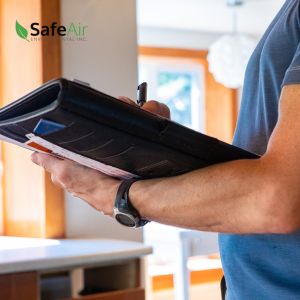How to Prevent Carbon Monoxide Poisoning with Air Quality Testing in Toronto
Posted in Air Quality, on November 27, 2023
This winter, protect your family from the life-threatening effects of carbon monoxide poisoning with air quality testing in Toronto. While most homes are protected from carbon monoxide with detectors, the SafeAir team still often detects unhealthy amounts during indoor air quality testing — especially during the winter. Why and how is the silent killer active during the winter, and how can you protect your home? Read on to learn more about carbon monoxide’s deadly effect.
What Causes Carbon Monoxide Leaks
 Carbon monoxide is formed when fuel is used, such as when we use the barbeque, run our cars, or use our furnaces. Carbon monoxide has no smell or taste and is invisible, which is why its effect on our bodies is so dangerous; we don’t see it coming. Carbon monoxide leaks are common with older appliances that need upgrading or maintenance or through misuse of fuel-burning tools.
Carbon monoxide is formed when fuel is used, such as when we use the barbeque, run our cars, or use our furnaces. Carbon monoxide has no smell or taste and is invisible, which is why its effect on our bodies is so dangerous; we don’t see it coming. Carbon monoxide leaks are common with older appliances that need upgrading or maintenance or through misuse of fuel-burning tools.
Signs of Carbon Monoxide Poisoning
Since your nose is no help in identifying a carbon monoxide leak, folks often only know when it’s too late, and they’re experiencing the effects of CO poisoning. Signs to watch out for include:
- Headaches
- Dizziness
- Muscle weakness
- Nausea or vomiting
- Racing heart or chest pain
- Disorientation
- Loss of consciousness
If these signs sound familiar, you must get into fresh air immediately and call 911 or your gas company.
Carbon Monoxide Winter Safety Tips
Preventing CO buildup in your home is a matter of life and death. If you don’t already have a carbon monoxide detector installed on all levels of your home, you must get one as soon as possible. Hardware stores and even some grocery or home-goods stores will carry several brands. Part of the reason that SafeAir notices an increase in CO during the winter months is that there are many ways people accidentally create the gas through daily activities. Some of the common reasons we see an increase in carbon monoxide in indoor air quality are:
- Gas heaters or stoves run indoors or close to air intakes.
- Cars left idling or heating up in garages with the door closed.
- Using gas appliances that have not had recent maintenance.
- Exhaust vents blocked by snow or leaves.
When to Call the Air Quality Experts at SafeAir
Carbon monoxide poisoning can be more challenging to detect in the winter because many of the symptoms mimic the common cold or flu, which are often at their peak just as we’re turning the furnace on for the first time. One of the key clues that carbon monoxide might be behind your symptoms is that they alleviate or disappear once you’re outdoors or away from home.
However, this effect is common with many indoor air quality pollutants such as mold spores, dust, and VOCs. SafeAir always recommends indoor air quality testing when allergic reactions or strange symptoms seem centred on your home or living space. Careful, science-based testing can help alert you to problems with ventilation, humidity, mold, radon gas, and a host of other common indoor air pollutants. Early detection of carbon monoxide poisoning won’t just alleviate the symptoms— it will also save your life. To book indoor air quality testing in Toronto or the GTA.

